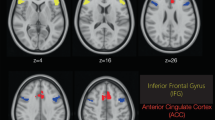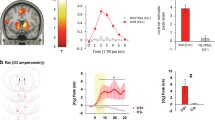Abstract
Rationale
Validating preclinical biomarkers that predict treatment efficacy remains a critical imperative for neuropsychiatric drug discovery. With the establishment of novel in vivo imaging methods, it has become possible to think how such translational proof-of-concept studies may look.
Objectives
The aim of this study was to use in vivo oxygen (O2) amperometry to simultaneously assess the regional and event/task-related O2 changes induced by ketamine challenge in rats, and to determine whether both of these signals are equivalently affected by the mGlu2/3 receptor agonist LY379268.
Methods
O2 signals were measured via carbon paste electrodes implanted in the anterior cingulate cortex (ACC) of rats trained to perform a simple reaction time task (SRT). SRT performance, event-related ACC O2 responses, and regional ACC O2 signal were recorded simultaneously in animals treated with ketamine (10 mg/kg) and/or LY379268 (3 mg/kg).
Results
A consistent relationship was observed between baseline SRT performance and related ACC O2 signals, suggesting that ACC engagement is likely to be a requirement for optimal task performance. Ketamine induced a robust and consistent slowing in reaction times that was reflected by a delayed event-related ACC O2 signal increase compared to vehicle controls. Ketamine also produced a regional and task-independent 60-min increase in ACC O2 levels which was effectively attenuated by LY379268. However, LY379238 failed to reverse alterations in event-related O2 signals and associated SRT task performance.
Conclusions
These findings raise questions about the degree to which such reversals of regional ketamine O2 signals could potentially be claimed to predict drug treatment efficacy.





Similar content being viewed by others

References
Arrowsmith J, Miller P (2013) Trial watch: phase II and phase III attrition rates 2011–2012. Nat Rev Drug Discov 12:569. doi:10.1038/nrd4090
Baker S, Chin CL, Basso AM, Fox GB, Marek GJ, Day M (2012) Xanomeline modulation of the blood oxygenation level-dependent signal in awake rats: development of pharmacological magnetic resonance imaging as a translatable pharmacodynamic biomarker for central activity and dose selection. J Pharmacol Exp Ther 341:263–273. doi:10.1124/jpet.111.188797
Birkett P, Sigmundsson T, Sharma T, Toulopoulou T, Griffiths TD, Reveley A, Murray R (2007) Reaction time and sustained attention in schizophrenia and its genetic predisposition. Schizophr Res 95:76–85
Carter CS, Braver TS, Barch DM, Botvinick MM, Noll D, Cohen JD (1998) Anterior cingulate cortex, error detection, and the online monitoring of performance. Science 280:747–749
Cartmell J, Monn JA, Schoepp DD (1999) The metabotropic glutamate 2/3 receptor agonists LY354740 and LY379268 selectively attenuate phencyclidine versus d-amphetamine motor behaviors in rats. J Pharmacol Exp Ther 291:161–170
Chin CL, Upadhyay J, Marek GJ, Baker SJ, Zhang M, Mezler M, Fox GB, Day M (2011) Awake rat pharmacological magnetic resonance imaging as a translational pharmacodynamic biomarker: metabotropic glutamate 2/3 agonist modulation of ketamine-induced blood oxygenation level dependence signals. J Pharmacol Exp Ther 336:709–715. doi:10.1124/jpet.110.173880
Dickinson D, Ramsey ME, Gold JM (2007) Overlooking the obvious: a meta-analytic comparison of digit symbol coding tasks and other cognitive measures in schizophrenia. Arch Gen Psychiatry 64:532–542
Doyle OM, De Simoni S, Schwarz AJ, Brittain C, O’Daly OG, Williams SC, Mehta M, Doyle OM, De Simoni S, Schwarz AJ, Brittain C, O’Daly OG, Williams SC, Mehta MA (2013) Quantifying the attenuation of the ketamine pharmacological magnetic resonance imaging response in humans: a validation using antipsychotic and glutamatergic agents. J Pharmacol Exp Ther 345:151–160. doi:10.1124/jpet.112.201665
Drummond SP, Bischoff-Grethe A, Dinges DF, Ayalon L, Mednick SC, Meloy MJ (2005) The neural basis of the psychomotor vigilance task. Sleep 28:1059–1068
Francois J, Conway MW, Lowry JP, Tricklebank MD, Gilmour G (2012) Changes in reward-related signals in the rat nucleus accumbens measured by in vivo oxygen amperometry are consistent with fMRI BOLD responses in man. Neuroimage 60:2169–2181. doi:10.1016/j.neuroimage.2012.02.024
Francois J, Huxter J, Conway MW, Lowry JP, Tricklebank MD, Gilmour G (2014) Differential contributions of infralimbic prefrontal cortex and nucleus accumbens during reward-based learning and extinction. J Neurosci 34:596–607. doi:10.1523/JNEUROSCI.2346-13.2014
Gastambide F, Mitchell SN, Robbins TW, Tricklebank MD, Gilmour G (2013) Temporally distinct cognitive effects following acute administration of ketamine and phencyclidine in the rat. Eur Neuropsychopharmacol 23:1414–1422. doi:10.1016/j.euroneuro.2013.03.002
Gilmour G, Pioli EY, Dix SL, Smith JW, Conway MW, Jones WT, Loomis S, Mason R, Shahabi S, Tricklebank MD (2009) Diverse and often opposite behavioural effects of NMDA receptor antagonists in rats: implications for “NMDA antagonist modelling” of schizophrenia. Psychopharmacology (Berl) 205:203–216. doi:10.1007/s00213-009-1530-7
Gilmour G, Dix S, Fellini L, Gastambide F, Plath N, Steckler T, Talpos J, Tricklebank M (2012) NMDA receptors, cognition and schizophrenia—testing the validity of the NMDA receptor hypofunction hypothesis. Neuropharmacology 62:1401–1412. doi:10.1016/j.neuropharm.2011.03.015
Gozzi A, Large CH, Schwarz A, Bertani S, Crestan V, Bifone A (2008) Differential effects of antipsychotic and glutamatergic agents on the phMRI response to phencyclidine. Neuropsychopharmacology 33:1690–1703
Hitchman ML (1978) Measurement of dissolved oxygen. Wiley, Canada
Imre G, Salomons A, Jongsma M, Fokkema DS, Den Boer JA, Ter Horst GJ (2006) Effects of the mGluR2/3 agonist LY379268 on ketamine-evoked behaviours and neurochemical changes in the dentate gyrus of the rat. Pharmacol Biochem Behav 84:392–399
Insel TR (2014) The NIMH Research Domain Criteria (RDoC) project: precision medicine for psychiatry. Am J Psychiatry 171:395–397. doi:10.1176/appi.ajp.2014.14020138
Insel T, Cuthbert B, Garvey M, Heinssen R, Pine DS, Quinn K, Sanislow C, Wang P (2010) Research domain criteria (RDoC): toward a new classification framework for research on mental disorders. Am J Psychiatry 167:748–751. doi:10.1176/appi.ajp.2010.09091379
Krystal JH, Abi-Saab W, Perry E, D’Souza DC, Liu N, Gueorguieva R, McDougall L, Hunsberger T, Belger A, Levine L, Breier A (2005) Preliminary evidence of attenuation of the disruptive effects of the NMDA glutamate receptor antagonist, ketamine, on working memory by pretreatment with the group II metabotropic glutamate receptor agonist, LY354740, in healthy human subjects. Psychopharmacology (Berl) 179:303–309. doi:10.1007/s00213-004-1982-8
Li J, Ishiwari K, Conway MW, Francois J, Huxter J, Lowry JP, Schwarz AJ, Tricklebank M, Gilmour G (2014) Dissociable effects of antipsychotics on ketamine-induced changes in regional oxygenation and inter-regional coherence of low frequency oxygen fluctuations in the rat. Neuropsychopharmacology 39:1635–1644. doi:10.1038/npp.2014.10
Logothetis NK, Pauls J, Augath M, Trinath T, Oeltermann A (2001) Neurophysiological investigation of the basis of the fMRI signal. Nature 412:150–157. doi:10.1038/35084005
Lowry JP, Boutelle MG, Fillenz M (1997) Measurement of brain tissue oxygen at a carbon past electrode can serve as an index of increases in regional cerebral blood flow. J Neurosci Methods 71:177–182
McHugh SB, Fillenz M, Lowry JP, Rawlins JN, Bannerman DM (2011) Brain tissue oxygen amperometry in behaving rats demonstrates functional dissociation of dorsal and ventral hippocampus during spatial processing and anxiety. Eur J Neurosci 33:322–337. doi:10.1111/j.1460-9568.2010.07497.x
Moghaddam B, Adams BW (1998) Reversal of phencyclidine effects by a group II metabotropic glutamate receptor agonist in rats. Science 281:1349–1352
Morgan P, Van Der Graaf PH, Arrowsmith J, Feltner DE, Drummond KS, Wegner CD, Street SD (2012) Can the flow of medicines be improved? Fundamental pharmacokinetic and pharmacological principles toward improving Phase II survival. Drug Discov Today 17:419–424. doi:10.1016/j.drudis.2011.12.020
Mulert C, Gallinat J, Dorn H, Herrmann WM, Winterer G (2003) The relationship between reaction time, error rate and anterior cingulate cortex activity. Int J Psychophysiol 47:175–183
Naito E, Kinomura S, Geyer S, Kawashima R, Roland PE, Zilles K (2000) Fast reaction to different sensory modalities activates common fields in the motor areas, but the anterior cingulate cortex is involved in the speed of reaction. J Neurophysiol 83:1701–1709
Ngan ET, Liddle PF (2000) Reaction time, symptom profiles and course of illness in schizophrenia. Schizophr Res 46:195–201
Paus T (2001) Primate anterior cingulate cortex: where motor control, drive and cognition interface. Nat Rev Neurosci 2:417–424. doi:10.1038/35077500
Pitsikas N, Markou A (2014) The metabotropic glutamate 2/3 receptor agonist LY379268 counteracted ketamine-and apomorphine-induced performance deficits in the object recognition task, but not object location task, in rats. Neuropharmacology 85:27–35. doi:10.1016/j.neuropharm.2014.05.008
Ragozzino ME, Rozman S (2007) The effect of rat anterior cingulate inactivation on cognitive flexibility. Behav Neurosci 121:698–706
Rorick-Kehn LM, Johnson BG, Knitowski KM, Salhoff CR, Witkin JM, Perry KW, Griffey KI, Tizzano JP, Monn JA, McKinzie DL, Schoepp DD (2007) In vivo pharmacological characterization of the structurally novel, potent, selective mGlu2/3 receptor agonist LY404039 in animal models of psychiatric disorders. Psychopharmacology (Berl) 193:121–136. doi:10.1007/s00213-007-0758-3
Shallice T, Stuss DT, Picton TW, Alexander MP, Gillingham S (2008) Multiple effects of prefrontal lesions on task-switching. Front Hum Neurosci 1:2. doi:10.3389/neuro.09.002.2007
Stuss DT, Alexander MP, Shallice T, Picton TW, Binns MA, Macdonald R, Borowiec A, Katz DI (2005) Multiple frontal systems controlling response speed. Neuropsychologia 43:396–417
Vallesi A, McIntosh AR, Crescentini C, Stuss DT (2012) fMRI investigation of speed-accuracy strategy switching. Hum Brain Mapp 33:1677–1688. doi:10.1002/hbm.21312
Vinogradov S, Poole JH, Willis-Shore J, Ober BA, Shenaut GK (1998) Slower and more variable reaction times in schizophrenia: what do they signify? Schizophr Res 32:183–190
Yanaka HT, Saito DN, Uchiyama Y, Sadato N (2010) Neural substrates of phasic alertness: a functional magnetic resonance imaging study. Neurosci Res 68:51–58. doi:10.1016/j.neures.2010.05.005
Financial disclosure
Jennifer Francois, Francois Gastambide, Michael Warwick Conway, Mark Tricklebank and Gary Gilmour declare being employees of Eli Lilly & Co Ltd. The research leading to these results has received support from the Innovative Medicines Initiative Joint Undertaking under grant agreement no. 115008 of which resources are composed of EFPIA in-kind contribution and financial contribution from the European Union’s Seventh Framework Programme (FP7/2007-2013).
Author information
Authors and Affiliations
Corresponding author
Additional information
Jennifer Francois and Francois Gastambide contributed equally to this work.
Electronic supplementary material
Below is the link to the electronic supplementary material.
ESM 1
(DOC 792 kb)
Rights and permissions
About this article
Cite this article
Francois, J., Gastambide, F., Conway, M.W. et al. Dissociation of mGlu2/3 agonist effects on ketamine-induced regional and event-related oxygen signals. Psychopharmacology 232, 4219–4229 (2015). https://doi.org/10.1007/s00213-015-3948-4
Received:
Accepted:
Published:
Issue Date:
DOI: https://doi.org/10.1007/s00213-015-3948-4



